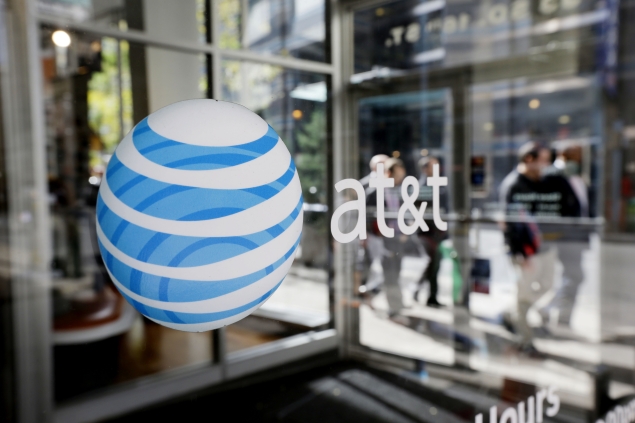- Home
- Telecom
- Telecom News
- AT&T quarterly profit misses Wall Street estimates despite increase in revenue
AT&T quarterly profit misses Wall Street estimates despite increase in revenue

AT&T's revenue was better than expected helped by growth of its wireless and enterprise businesses. But strong wireless growth comes at a cost because the company has to pay hefty subsidies for each new wireless customer it adds to its network.
"Both wireline and wireless revenue were a little better than I expected," said Hudson Square analyst Todd Rethemeier, but he noted that the difference was not big enough to boost the company's shares.
AT&T shares fell to $35.50 in late trade after closing at $35.81 on the New York Stock Exchange.
Revenue rose to $32.08 billion from $31.58 billion, compared with Wall Street expectations for $31.81 billion. Earnings per share of 67 cents, excluding unusual items, were a penny behind analysts' estimates, according to Thomson Reuters I/B/E/S.
The No. 2 U.S mobile service provider said it added more than 550,000 contract customers in the quarter, slightly ahead of its target for about 500,000 and an improvement from its 320,000 net additions in the year-ago quarter.
However, this pushed down its wireless profit margin based on earnings before interest, tax, depreciation and amortization (EBITDA) was 42.4 percent in the quarter compared with 45.8 percent in the second quarter of 2012, due to higher costs.
Its growth rate was still well behind the 941,000 net additions at bigger rival Verizon Wireless, which reported its financial results on July 18.
Smaller rivals Sprint Corp, which was recently bought by SoftBank Corp, and T-Mobile US have yet to report their second quarter results.
Since Sprint shut down an old network based on iDen technology in the quarter, much of AT&T's customer growth was likely from departing iDen customers, said Moffett Research analyst Craig Moffett.
"Absent the decommissioning of iDen, it's very likely they would have lost a significant number of phone subscribers in the quarter," said Moffett who also questioned where AT&T and Verizon Wireless growth will come from in coming quarters.
AT&T also faced additional competitive pressure in the quarter as smaller rival T-Mobile US started selling the Apple Inc iPhone, a top seller for AT&T.
But Ralph de la Vega, the head of AT&T wireless business, said that customer departures to T-Mobile, the No. 4 U.S. mobile provider, were "significantly less" than the defections it saw right after Sprint and Verizon Wireless launched the iPhone.
AT&T posted total earnings of $3.82 billion, or 71 cents per share, compared with $3.97 billion, or 66 cents per share, in the year-ago quarter.
Chief Financial Officer John Stephens said on a conference call with analysts that despite a challenging economy AT&T still saw some improvements in its enterprise business, which is one of the most vulnerable to economic fluctuations.
"Even with little help from the economy, business wireline showed sequential improvement," Stephens said.
He said the company was on track to meet its targets for revenue and earnings growth for the full year. AT&T had forecast 2 percent revenue growth for the year.
The company also promised that 2013 wireless service margins would be better than in 2012. It is expecting lower device costs because of a longer phone upgrade limit for customers who sign a two-year contract as well as a new device upgrade plan where consumers pay full cost for their phone.
Both AT&T and Verizon drew ire from analysts and rival T-Mobile by introducing separate device payment plans without reducing the monthly service fees.
AT&T said it added 233,000 U-verse TV subscribers in the quarter, leaving it with more than 5 million TV customers. Including Internet customers, it said it had 9.4 million total U-verse subscribers at the end of the quarter.
© Thomson Reuters 2013
For the latest tech news and reviews, follow Gadgets 360 on X, Facebook, WhatsApp, Threads and Google News. For the latest videos on gadgets and tech, subscribe to our YouTube channel. If you want to know everything about top influencers, follow our in-house Who'sThat360 on Instagram and YouTube.
Related Stories
- Samsung Galaxy Unpacked 2025
- ChatGPT
- Redmi Note 14 Pro+
- iPhone 16
- Apple Vision Pro
- Oneplus 12
- OnePlus Nord CE 3 Lite 5G
- iPhone 13
- Xiaomi 14 Pro
- Oppo Find N3
- Tecno Spark Go (2023)
- Realme V30
- Best Phones Under 25000
- Samsung Galaxy S24 Series
- Cryptocurrency
- iQoo 12
- Samsung Galaxy S24 Ultra
- Giottus
- Samsung Galaxy Z Flip 5
- Apple 'Scary Fast'
- Housefull 5
- GoPro Hero 12 Black Review
- Invincible Season 2
- JioGlass
- HD Ready TV
- Laptop Under 50000
- Smartwatch Under 10000
- Latest Mobile Phones
- Compare Phones
- Moto G15 Power
- Moto G15
- Realme 14x 5G
- Poco M7 Pro 5G
- Poco C75 5G
- Vivo Y300 (China)
- HMD Arc
- Lava Blaze Duo 5G
- Asus Zenbook S 14
- MacBook Pro 16-inch (M4 Max, 2024)
- Honor Pad V9
- Tecno Megapad 11
- Redmi Watch 5
- Huawei Watch Ultimate Design
- Sony 65 Inches Ultra HD (4K) LED Smart TV (KD-65X74L)
- TCL 55 Inches Ultra HD (4K) LED Smart TV (55C61B)
- Sony PlayStation 5 Pro
- Sony PlayStation 5 Slim Digital Edition
- Blue Star 1.5 Ton 3 Star Inverter Split AC (IC318DNUHC)
- Blue Star 1.5 Ton 3 Star Inverter Split AC (IA318VKU)
















